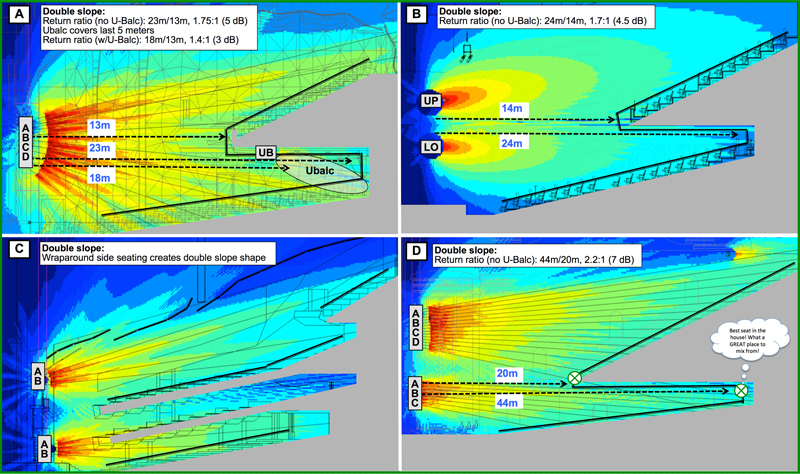
There’s one more height-related consideration: the coverage pattern bending often termed “smiles and frowns.” This is relevant to high and low orientation to balcony fronts (and our attempts to avoid them).
Only a vertically centered main can be precisely steered to overcome a high return ratio. Upper or lower positions cause the coverage transition to appear at different heights across the room.
Here’s the consolation for this exercise. All is not lost when we raise the white flag and divide the array into upper and lower sections. Instead of trying to make one array do something it hates to do (double sloping), we get two arrays being what they love to be: asymmetric coupled point sources drawing a single slope. The ripple variance in the low end might be a very small price for this payoff.
The design process is basically a two-layer cake. Upper and lower are separately analyzed and comparably power scaled.
In some cases it’s possible to move the upper main deeper into the house (since it starts at the balcony). This is free money in terms of power and signal/noise ratio, as long as the image is not compromised.
Balcony Fronts
There’s an old expression to sum up the sound engineer’s perspective on this: The only good balcony front is a dead balcony front. “Balcophobia” is a serious malady in the sound community. Designers go to great lengths to avoid what acousticians go to great lengths to install: lively balcony fronts. We’ve all been burned by this, so it’s worth a few paragraphs to put things in proper perspective. Some balconies are poisonous but others are harmless, but many of us run from both kinds.
Bad balconies are tall, lively, featureless (single angle, not diffuse). Glass and steel (bad). They also have lousy angles with respect to our loudspeakers, sending sound back on stage or onto paying patrons. Even worse (the worst) is the flat, curved balcony in a fan shaped room with the stage as it’s focal point. Been there, done that.
Good balconies are short, dead, diffuse, filled with lighting gear, multi-angled and inclined to send our sound harmlessly into the open air such as the ceiling. Size up the live surfaces of your local balcony. It’s harmless below 500 Hz if it’s less than 0.5 meters tall. The key is to not to hurt the design over avoiding something that won’t hurt you (Figure 4).

